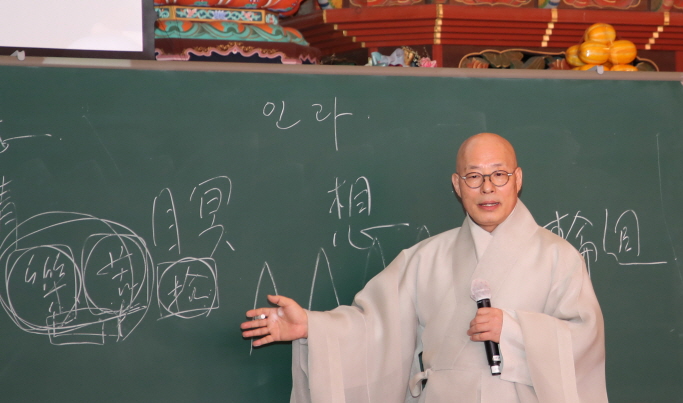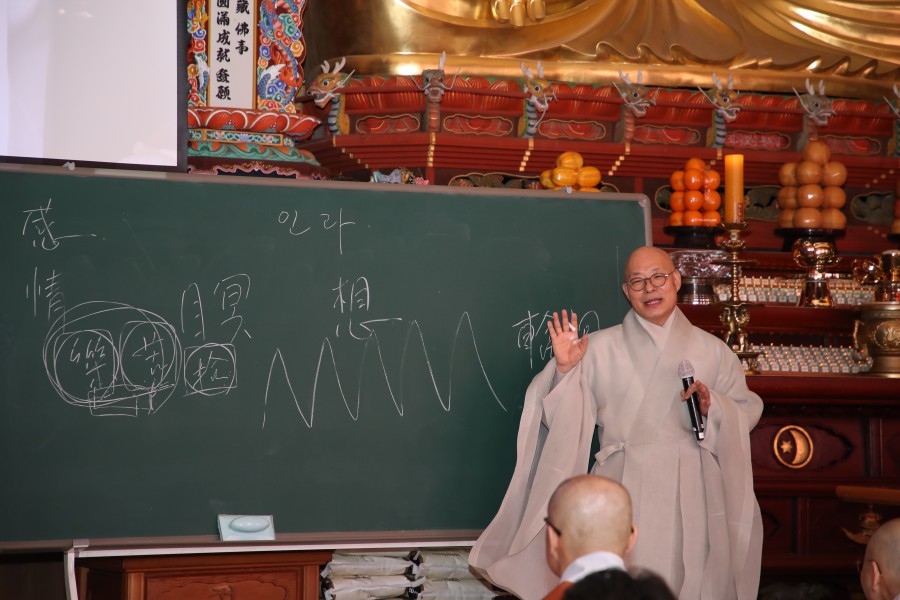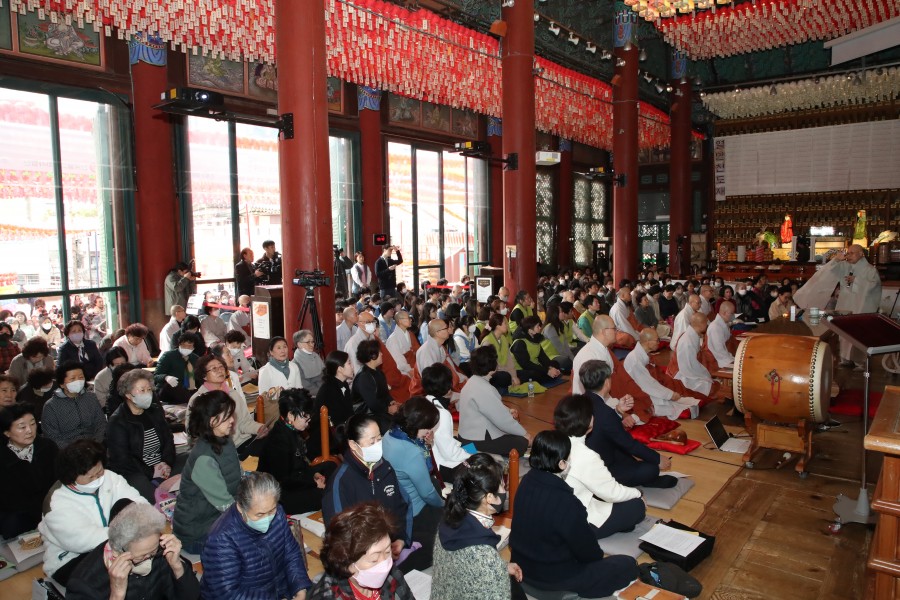English | Ven. Jinwoo, the First Speaker of a Series of Dharma Talks at Jogyesa Temple for Buddha’s Renunciation & Parinirvana Day
Page information
Author Jogye On24-03-28 10:21 Views3,651 Comments0Related links
Body

The assembly was organized around the theme of "Finding Inner Peace through Seon Meditation". It was hold during the week of Buddha’s Renunciation and Parinirvana Day, and authorized by Ven. Wonmyung, Jogyesa's abbot. From March 17th, Buddha’s Renunciation Day, to March 24th, Parinirvana Day (the 2nd month, and the 15th day of the lunar calendar), Ven. Jinwoo, along with seven other Dharma masters, delivered teachings on Seon meditation and guided the participants in practice.
Ven. Jinwoo explained Seon meditation in a way that resonated with the understanding of Buddhist practitioners. He said, “I am the first speaker of the series of Dharma talks on Seon meditation and it is more significant that it coincides with Buddha’s Renunciation Day.”
The venerable emphasized that "meditation encompasses everything aimed at calming the mind," and pointed out that practices such as chanting, reading scriptures, studying Buddhist doctrines, and Seon meditation can all be considered as meditation. He particularly highlighted Korea's long and unique tradition of Seon meditation, which focuses on calming the mind to attain enlightenment. He explained, "Guanhwaseon, which I call Huatou meditation, is indeed the supreme method of practice. However, because it may be difficult for ordinary people to engage in Guanhwaseon right away, I advise them to start with regular meditation."
The venerable continued by elucidating three fundamental teachings that one must understand before engaging in meditation: causality, impermanence, and the middle way. He explained, “When asked what causality is, people often say that if you do good deeds, you'll have good results, and if you do bad deeds, you'll have bad results. However, this is a simplistic view. The true meaning of causality, as the Buddha taught, is ‘This is, because that is. This is not, because that is not.'”

He stressed that everything in this world is subject to causality. Night follows day, and death follows being born. When the favorable arises, the unfavorable inevitably arises as well. The simultaneous presence of opposites is the mundane world. This and that always co-exist. Without suffering, pleasure does not arise. However, because there is suffering, pleasure arises; and because there is pleasure, suffering also arises. This is what the Buddha referred to as 'this and that.' This is causality.
The venerable emphasized, "Realization comes from understanding that everything I hear and see is of my own making; Otherwise, it is ignorance. To be a successful meditator, one must understand that everything in this world is constituted by causality."
He said, "All sentient beings are subject to causality. Causality is pleasure and displeasure; pleasure and displeasure is karma. Karma is indeed causality. By resolving causality, karma disappears. When pleasure and displeasure vanishes, ultimately it is the middle way." He referred to the elimination of causality as the cessation of karma. When this is completely eradicated, it's called emptiness. Emptiness doesn't merely mean voidness. It signifies the absence of emotions such as pleasure and displeasure; worries, anxieties, pains, and sufferings vanish. This is referred to as emptiness, the middle way, and transcendence from the cycle of life and death, hence called Nirvana.
The venerable added, “Because of the causality where happiness leads to unhappiness, the Buddha refrained from frequent use of the term happiness and instead referred to it as 'Anuttarasamyaksambodhi' in the Diamond Sutra. The Buddha mentioned regarding the physical phenomenon of living beings, but being alive doesn't necessarily mean feeling pleasant or happy; it simply implies being at ease.”
Furthermore, what the Buddha emphasized is dependent origination. Ven. Jinwoo stated, "Everything in Samsara are interconnected, arising from causes and conditions, so there is no one to blame. In Buddhism, there is no absolute right or wrong; it's just the workings of karma. When we argue about right and wrong, it's merely an attempt to satisfy ourselves by winning arguments and teaching others, all for the sake of personal satisfaction." He continued, "Since as much suffering arises as pleasure I obtain, and as much happiness arises as unhappiness I obtain, there is no need to create disputes over right and wrong. Therefore, the Buddha advised not to stir the mind."
He continued, "To refrain from stirring the mind, one must cultivate tranquility. That is meditation." Not giving rise to birth and death, not generating karma, is meditation. He added, "The fundamental purpose of meditation is to tranquilize one’s mind. Completely eliminating emotions is the cessation of karma and liberation. To cease the cycle of reincarnation, one must cultivate meditation."
As mentioned earlier, the purpose of meditation is to tranquilize the mind, meaning that there should be no unpleasant feelings in one's actions, speech, and thoughts. This is known as the purification of the three karmas. The venerable said, "First, one must transcend the disputes of liking and disliking, right and wrong. Engage in practices such as chanting, reading scriptures, and meditation, concentrating without any distractions, and refrain from generating deluded thoughts and fantasies.”
The venerable added, "Meditation is about tranquilizing the mind, and to tranquilize the mind, one must discard the three poisonous minds. To discard the three poisonous minds, one must purify the three karmas and always entrust oneself to dependent origination." It means realizing that there is neither right nor wrong, good nor bad in all that one perceives, and simply trusting in Buddha is sufficient.
He called upon, "Even if one were to follow the bodhisattva's path of Six Perfections, his or her mind becomes even more tranquil and peaceful. When one practices meditation, the Dharma of this world naturally become apparent. The workings of causality, dependent origination and the middle way are understood spontaneously. Therefore, meditation is necessary.”
△Ven. Wol-am (Head of the meditation monastery of Hansansa Temple)
‘Platform Sutra and Daily Meditation’ (March 18)
△ Ven. Myong-beop (Abbot of Kugilam of Haeinsa Temple)
‘Seon Meditation, a Self-Healing Life’ (March 19)
△ Ven.Geum-kang (Professor at Jung-ang Sangha University, Abbot of Chamseon Village in Anseung)
‘Seon Meditation Practice of True Person’ (March 20)
△ Ven.Il-muk (Abbot of Jetavana Monastery)
‘Taming the mind into Samadhi’ (March 21)
△Ven.In-kyong (President of Korean Meditation Counseling Research)
‘Parinirvanna – Buddha nature and Seon Meditation’ (March 22)
△Ven.Seo-kwang (Director of Korean meditation counseling Resesearch)
‘Seon meditation, Spiritual Journey of Healing’ (March 23)
△Ven. Jinwoo (President of the Jogye Order of Korean Buddhism)
‘Seon Meditation in Daily Life’ (March 24)



